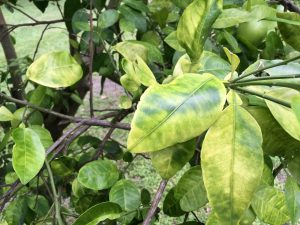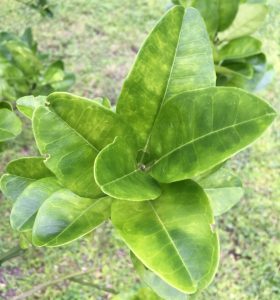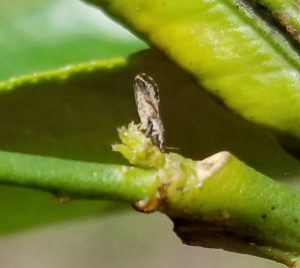Citrus Greening Disease Basic Info:

Citrus greening disease, also called Huanglongbing (HLB), is the most devastating disease of citrus worldwide (Figure 1). It is caused by the phloem-limited bacterium Candidatus Liberibacter asiaticus (CLas), which is spread from tree-to-tree by Diaphorina citri, the Asian citrus psyllid (ACP). The CLas bacterium inhabits the phloem of the plant, and disrupts the normal transport of sugars produced by photosynthesis in the leaves to the other plant parts that need them (flowers, fruits, roots, seeds). This disruption ultimately leads to plant weakness and death. All commercial varieties of citrus are susceptible to this disease. Since its first confirmation in 2005, citrus greening disease in Florida has resulted in over a 70% decline in citrus production.
Symptoms of Citrus Greening:

The symptoms of citrus greening are often not apparent for the first year or two after infection with the bacterium. This can lead to the disease going unnoticed until it has already spread to other nearby citrus trees. Once the disease has progressed, the best diagnostic symptom of citrus greening is “blotchy mottle” (Figure 2). Blotchy mottle is a random pattern of chlorosis (yellowing) on leaves. Unlike nutrient deficiencies and other issues that may cause chlorosis (and appear superficially similar), the blotchy mottle of citrus greening disease is asymmetrical (meaning that is not the same on the right and left sides of the leaf). As the disease worsens, affected trees will progressively decline and the fruit produced can become misshapen, discolored, and bitter.
Citrus Greening and Asian Citrus Psyllids in Georgia:

Georgia has been quarantined for citrus greening disease and the Asian citrus psyllid (Figure 3) since 2009, when the disease was discovered in residential citrus trees near Savannah, GA. In 2016, the disease was identified in Camden County, and is currently widespread in residential citrus there. Surveys by the Georgia Department of Agriculture for the Asian citrus psyllid vectors of citrus greening have identified the psyllid in every coastal county within Georgia (Chatham, Bryan, Liberty, McIntosh, Glynn, and Camden) as well as in Effingham and Charlton counties. In addition, UGA Cooperative Extension identified the Asian citrus psyllid in Lowndes County in 2018.